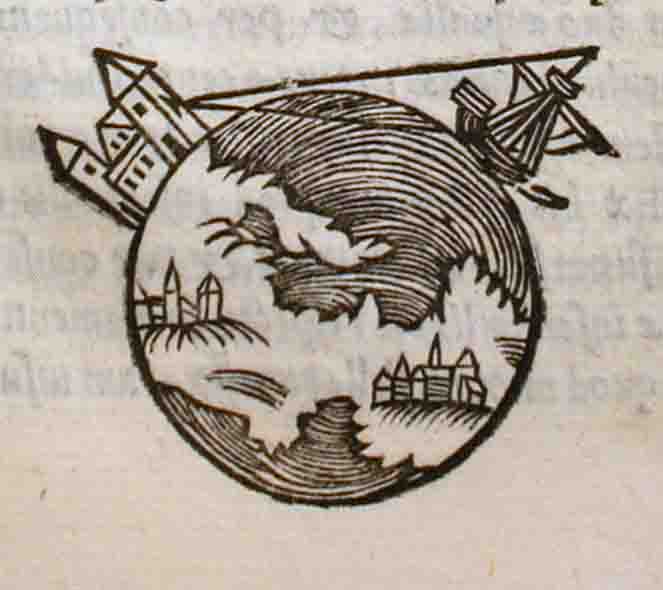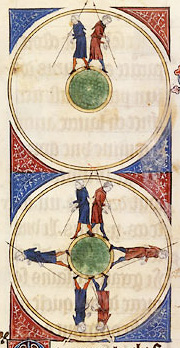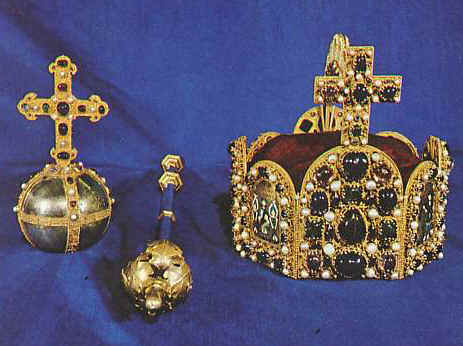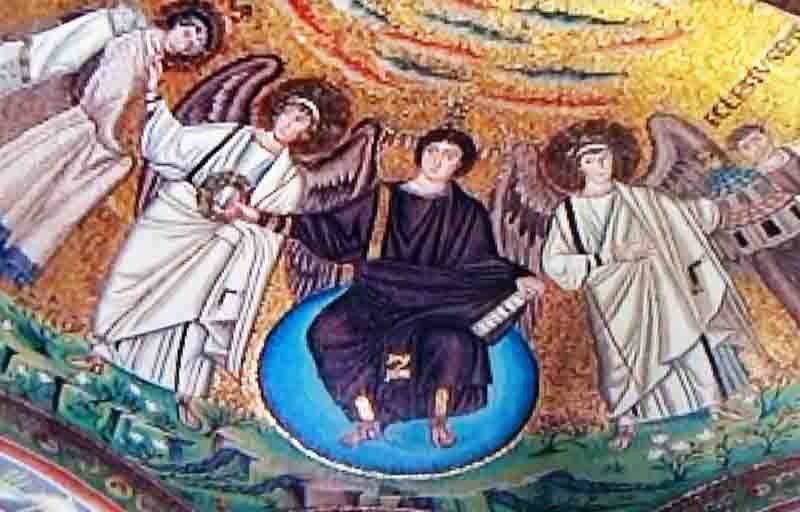Flat Earth Myth - More Bogus History
|
Flat Earth |
Creating Bogus History
What is the Myth About the
Flat Earth ?
The myth is NOT that the people in the so called “Dark Ages” or even
that the people in the Middle Ages thought the earth was flat. These
people clearly knew then as well as people do now that the earth is not
flat, but rather spherical, more or less, in shape.
See the multiple pieces of evidence here on this web page.
The Myth is the modern thought that falsely accused the Christians
living in the Middle Ages ( that is, in the sixth century or even
arguably before that) of being intellectually hampered by religion. This
modern myth falsely accuses these people of thinking the earth is flat.
Why is this Important ?
This myth, that the early Christians were ignorant and that their
thought process was hampered by religion, was started by atheists who
wished to oppose and oppress Christianity.
Dan Brown’s book and movie The Da Vinci Code claims that Christianity
opposes true science. Let us look at another example of how the truth
can be
totally misrepresented.
A popular story teller, in this case Washington Irvin (1783-1859), created his own “truth” to make his story more interesting. In this case, his fictionalized history later became accepted as a “Fact.”
Partly due to his influence as well as others, it is now often presupposed that the Medieval Times were the “Dark Ages” and that the Catholic Church suppressed intellectual thought and the sciences. For example, Washington Irving portrayed Christopher Columbus as a simple mariner who had to confront the oppressive hooded Spanish inquisitors of his time.
According to Irving, Columbus had to convince Queen Isabella to go against her religious advisors who, supposedly, thought he would fall of the edge as he sailed into the West because the earth is flat.
This perception that most all of Europe believed that the Earth was flat is totally erroneous. Almost everyone in the Middle Ages believed that the Earth was spherical in shape.
This “Flat Earth” theory was simultaneously established by Washington Irving and a Frenchman, Antoine-Jean Letronne (1787-1848), who had strong antireligious prejudices.
In 1828 Washington Irving published his book, The Life and Voyages of Christopher Columbus.
However, before the 1828 no one believed in this myth that the Europeans believed the earth was flat.
This theory was enabled to grow in part by the ideas advanced by Auguste Compte (1798-1857). He developed the idea of positivism and the concept of progress, step by step, from superstition to science.
In 1896 Andrew Dickson White, the founder of Cornell University, wrote his “History of the warfare of science with theology in Christendom.” He further advanced this Flat Earth theory. He depicted religion as something that needed to be swept away to make room for “real” science.
Andrew Dickson White promotes this ludicrous falling-off-the-edge theory, which had no basis in fact whatsoever, with his following statement:
“Many a bold navigator who was quite ready to brave pirates and tempests, trembled at the thought of tumbling with his ship into one of the openings into hell which a widespread belief placed in the Atlantic at some unknown distance from Europe. This terror among sailors was one of the main obstacles in the great voyage of Columbus.”
By the end of the 1800’s and onward to just recently, practically all secondary school text books erroneously promoted this myth that those in the Medieval Ages believed the earth was flat.
However, even before Columbus most everyone in the Church believed that the earth was globe shaped. Sailors knew that a person positioned in a “crow’s nest” would have a better perspective due to the earth’s curvature. Even Dante’s Divine Comedy portrays Earth as a sphere. And it was written between 1306-1321 AD. Clement, Origen, Ambrose, Augustine, Isodore, Venerable Bede, Albertus Magnus and Aquinas all acknowledged the earth as spherical.
Jeffrey Burton Russell exposed this myth in his book, Inventing the Flat Earth: Columbus and Modern Historians (New York: Praeger, 1991). He explains:
“If Christians had for centuries insisted that the earth was flat against clear and available evidence,” explains Russell, “they must be not only enemies of scientific truth, but contemptible and pitiful enemies.”
And thus, a person can perceive the possible motivations that a person might have for wanting to invent or promote this “Flat Earth Myth.”
Notes from Wiki:
Learned Christian authors such as Basil of Caesarea
(died AD 379), Ambrose and Augustine of Hippo (died AD 430) were clearly
aware of the sphericity of the Earth. From the 8th century and the
beginning medieval period, "no cosmographer worthy of note has called
into question the sphericity of the Earth."
[Source: Klaus Anselm Vogel,
"Sphaera terrae – das mittelalterliche Bild der Erde und die
kosmographische Revolution," PhD dissertation Georg-August-Universität
Göttingen, 1995, p. 19.]
Bede the Venerable
The monk Bede (c. 672–735) wrote in his influential treatise on computus, The Reckoning of Time, that the Earth was round. He explained the unequal length of daylight from
"the roundness of the Earth, for not without reason is it called 'the orb of the world' on the pages of Holy Scripture and of ordinary literature. It is, in fact, set like a sphere in the middle of the whole universe."
(De temporum ratione, 32).
Bede was lucid about earth's sphericity, writing
"We call the earth a globe, not as if the shape of a sphere were
expressed in the diversity of plains and mountains, but because, if all
things are included in the outline, the earth's circumference will
represent the figure of a perfect globe... For truly it is an orb placed
in the centre of the universe; in its width it is like a circle, and not
circular like a shield but rather like a ball, and it extends from its
centre with perfect roundness on all sides."
[
Russell, Jeffrey B. 1991. Inventing the
Flat Earth. New York: Praeger Publishers. p. 87.]
Ælfric of Eynsham paraphrased Bede into Old
English, saying, "Now the Earth's roundness and the Sun's orbit
constitute the obstacle to the day's being equally long in every land."
[
Ælfric of Eynsham, On the Seasons of the
Year, Peter Baker, trans]
Saint Hildegard (Hildegard von Bingen, 1098–1179), depicted the spherical earth several times in her work Liber Divinorum Operum.
The Elucidarium of Honorius Augustodunensis (c. 1120), an important manual for the instruction of lesser clergy, which was translated into Middle English, Old French, Middle High German, Old Russian, Middle Dutch, Old Norse, Icelandic, Spanish, and several Italian dialects, explicitly refers to a spherical Earth. Likewise, the fact that Bertold von Regensburg (mid-13th century) used the spherical Earth as an illustration in a sermon shows that he could assume this knowledge among his congregation. The sermon was preached in the vernacular German, and thus was not intended for a learned audience.
A non-exhaustive list of more than a hundred Latin and vernacular writers from Late Antiquity and the Middle Ages who were aware that the earth was spherical, has been compiled by Reinhard Krüger, professor for Romance literature at the University of Stuttgart.
Krüger's list of the 79 authors known by name
Late Antiquity
Ampelius, Chalcidius, Macrobius, Martianus Capella, Basil of Caesarea, Ambrose of Milan, Aurelius Augustinus, Paulus Orosius, Jordanes, Cassiodorus, Boethius, Visigoth king Sisebut.
Early Middle Ages
Isidore of Seville, Beda Venerabilis, Theodulf of Orléans, Vergilius of Salzburg, Irish monk Dicuil, Rabanus Maurus, King Alfred of England, Remigius of Auxerre, Johannes Scotus Eriugena, Leo of Naples (German), Gerbert d’Aurillac (Pope Sylvester II).
High Middle Ages
Notker the German of Sankt-Gallen, Hermann of Reichenau, Hildegard von Bingen, Petrus Abaelardus, Honorius Augustodunensis, Gautier de Metz, Adam of Bremen, Albertus Magnus, Thomas Aquinas, Berthold of Regensburg, Guillaume de Conches, Philippe de Thaon (French), Abu-Idrisi, Bernardus Silvestris, Petrus Comestor, Thierry de Chartres, Gautier de Châtillon, Alexander Neckam, Alain de Lille, Averroes, Snorri Sturluson, Moshe ben Maimon, Lambert of Saint-Omer, Gervasius of Tilbury, Robert Grosseteste, Johannes de Sacrobosco, Thomas de Cantimpré, Peire de Corbian, Vincent de Beauvais, Robertus Anglicus, Juan Gil de Zámora (Spanish), Ristoro d'Arezzo, Roger Bacon, Jean de Meung, Brunetto Latini, Alfonso X of Castile.
Late Middle Ages
Marco Polo, Dante Alighieri, Meister Eckhart, Enea Silvio Piccolomini (Pope Pius II), Perot de Garbalei (divisiones mundi), Cecco d'Ascoli, Fazio degli Uberti (Italian), Levi ben Gershon, Konrad of Megenberg, Nicole Oresme, Petrus Aliacensis, Alfonso de la Torre (German), Toscanelli, Brochard the German (German), Jean de Mandeville, Christine de Pizan, Geoffrey Chaucer, William Caxton, Martin Behaim, Christopher Columbus.
|
Flat Earth |
See Articles at
|
Spherical Evidence
|
||||
|
||||
The flattest thing on earth proved the earth was round - water. From the Middle Ages onward the sailors new that the view from the "crow's nest" on the ship's mast provided the best vantage point for distant objects because they knew the earth was spherical in shape. |
||||
 |
||||
| The above picture is from a AD 1550 edition of a
reproduction of the work On the Sphere of the World, which was originally written about AD. 1230. It was one of the most influential works of pre-Copernican astronomy in Europe. |
||||
|
|
||||
| Illustration of
the spherical earth in a medieval manuscript. The figure shows
two men walking around the spherical earth, one going to the
East and the other to the West, and meeting on the opposite
side.[1]
14th century copy of a 12th century original, by French Priest Poet Gautier de Metz L'Image du monde _the image of the world_ AD 1245
More recent images of Christ and the spherical globes, orbs. |
||||
|



